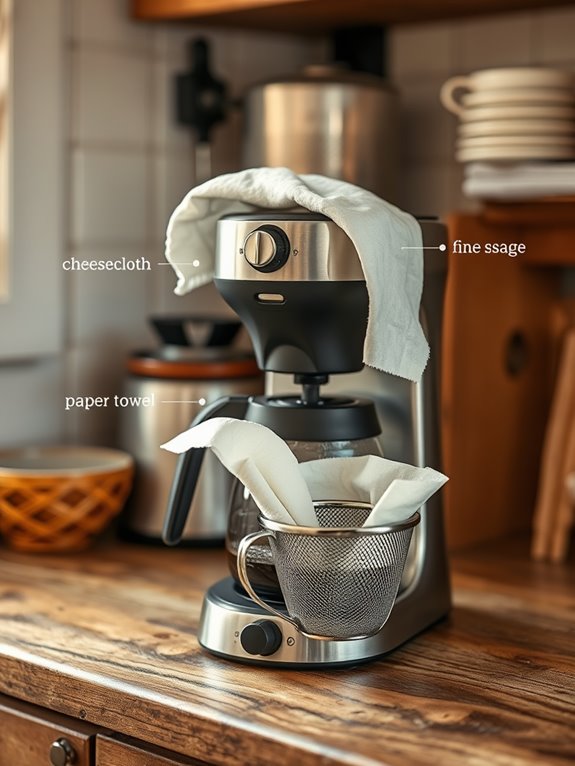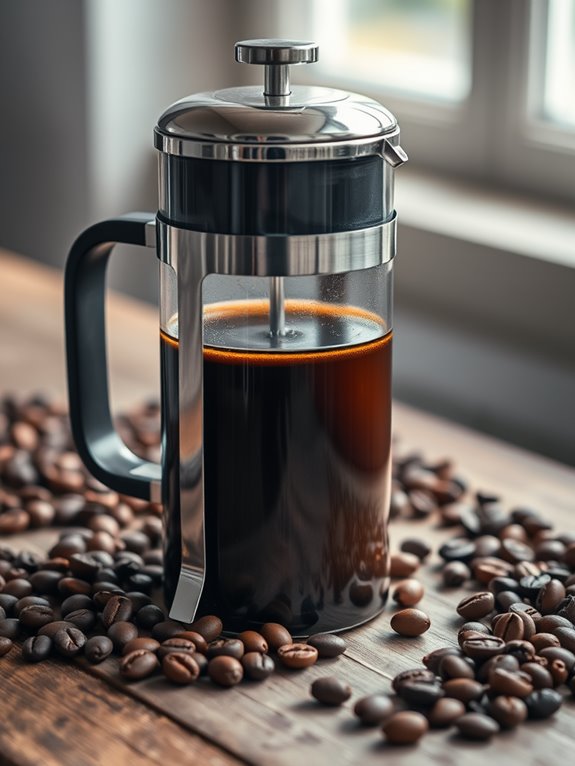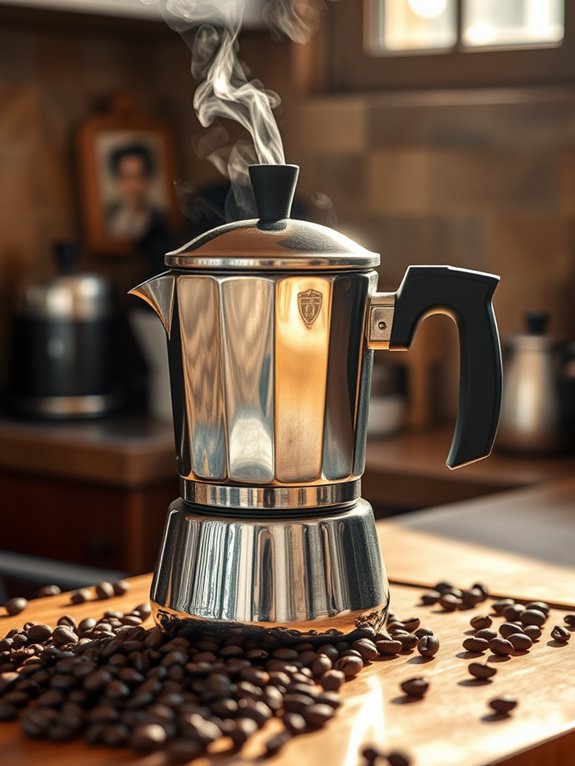Can You Use a Coffee Maker Without a Filter
You can use a coffee maker without a traditional filter by exploring creative alternatives. Try a makeshift filter like cheesecloth, a clean kitchen rag, or even a soft fabric secured with a rubber band over a mug. Just remember, using kitchen paper isn't ideal due to potential clogging and fire hazards. Each method offers a chance to experiment with varying flavors and brewing techniques. Let's uncover even more possibilities to enhance your coffee experience with improvisation!
Key Takeaways
- Using a coffee maker without a proper filter can lead to inconsistent brewing and poor flavor extraction.
- Cheesecloth or a clean kitchen rag can be a makeshift alternative to traditional coffee filters.
- Kitchen paper is not recommended as it may clog the machine and pose safety risks.
- Regular vinegar cleaning is essential for maintaining coffee maker performance with or without proper filters.
- Alternative brewing methods like a French press or stovetop percolator don't require traditional filters.
Exploring Makeshift Filter Alternatives

When you find yourself without a coffee filter, don't worry—there are many makeshift filter alternatives you can try. Mesh fabrics like cheesecloth or a clean kitchen rag can effectively substitute for a standard filter. Secure them over a mug with a rubber band. For ideal flavor, use a medium-fine grind and let boiled water cool for 20 seconds to 200°F before pouring. Allow your coffee grounds to bloom for 30 to 45 seconds, enhancing the brewing process. This method provides a practical, quick solution when conventional filters are unavailable, ensuring you still enjoy a good cup of coffee. Using a burr coffee grinder will ensure uniform grounds for optimal extraction with your makeshift filter. Remember, cheesecloth and kitchen rags are cost-effective solutions that offer a great alternative to traditional coffee preparation methods.
Kitchen Paper for Electric Machines
Let's investigate the use of kitchen paper as a filter in your electric coffee machine, especially when you're in a pinch. While it might seem like a handy substitute, kitchen paper isn't designed for this purpose and can lead to inconsistent brewing and flavor. The paper's fibers could break apart, clogging your machine and possibly causing damage. Safety concerns abound, from fire risks to electrical hazards. Here's a quick comparison:
| Consideration | Coffee Filters | Kitchen Paper |
|---|---|---|
| Heat Resistance | High | Low |
| Flavor Impartation | Minimal | Potentially Unwanted |
| Fiber Density | Dense | Sparse |
It's best to stick with proper coffee filters. Regular vinegar cleaning solution can help maintain optimal brewing performance when using proper filters.
French Press Method

The French Press method offers a straightforward and satisfying way to brew coffee, bringing out rich flavors without the need for paper filters.
Let's investigate this technique. Begin by preheating your French press with hot water. Grind the coffee beans coarsely, like breadcrumbs. Measure 56g of coffee for an 8-cup press.
Add hot water (205°F), filling halfway, then stir at one minute. Fill to the top, letting it steep for 3-4 minutes. Finally, press down firmly.
Use a burr grinder for consistent grind size and clean the press after each use to maintain flavor quality. Similar to medium roast blends, this method produces a smooth and rich coffee experience. Enjoy your hearty brew!
Brewing Turkish Coffee
As you hone the art of coffee making, Turkish coffee offers a fascinating journey into deep, rich flavors, crafted without the need for paper filters. You'll need a cezve, a small pot with a unique shape. This pot, often made of copper or stainless steel, is essential for brewing. Begin by grinding coffee beans finely and mix 1g coffee per 10g water. If you don't have a grinder, a mortar and pestle can effectively crush your beans to the right consistency.
Here's a quick guide:
| Step | Action | Result |
|---|---|---|
| 1 | Add coffee | Combine flavors |
| 2 | Mix gently | Even texture |
| 3 | Heat slowly | Foam forms |
Let's investigate these steps, ensuring you savor every sip.
Stovetop Percolators

While stovetop percolators might seem like a relic from the past, they offer a unique and rewarding way to brew coffee without the need for paper filters.
They use a metal filter basket, allowing water to circulate through the coffee grounds repeatedly until you reach the desired strength. This method can produce a rich, intense flavor, though manual control is key to avoid bitterness.
Made from durable stainless steel, these percolators require regular cleaning to maintain flavor quality. Consider using disc filters to reduce oily substances linked to cholesterol concerns.
Let's investigate this timeless method for a hearty coffee experience.
Using an AeroPress Without Filters
If you're curious about trying something new with your AeroPress, brewing coffee without a traditional filter can be an exciting experiment.
Let's investigate how to prepare it for no-filter brewing. Use your AeroPress like a dripper by removing the piston, creating an open chamber. This method benefits from the AeroPress's no bypass, flat bed, and tall vertical walls.
For ideal extraction, aim for a medium-coarse grind. Pour 240 grams of hot water for a single serving, and consider stirring and blooming to enhance flavors.
This unique approach allows more coffee oils and particles, offering a richer, more flavorful taste.
Cold Brew and Other No-Filter Techniques

Brewing coffee without a traditional filter can spark curiosity, and cold brew is a standout method worth trying.
Simply steep coarsely ground coffee in room-temperature water for 10 to 20 hours. Use a 1/4 cup coffee to 1 cup water ratio for a concentrated brew. This process creates a smooth, low-acid drink that stays fresh in your fridge for up to a week.
For hot coffee, investigate using paper towels, reusable tea bags, or cheesecloth as filters.
Each method adjusts the flavor profile, so experiment with different coffee-to-water ratios and grind sizes to find what suits your taste.







